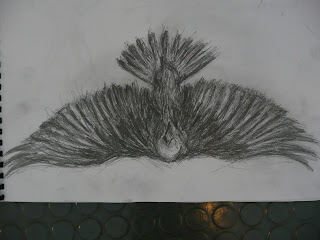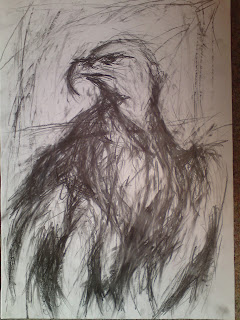Eagle sketch with graphite pencil
For our homework, we were asked to produce at least six drawings of birds and represent the different character traits given on the brief. To represent masculine birds, eagles came to mind instantly. As well as observing the detail within the face, I also wanted to incorporate bold pencil marks around the body to make the eagle look more intense, adding to the dramatic ,movement of the eagle.
Charcoal drawings of eagles
Some of the strongest pages in my sketchbook include these charcoal drawings of golden eagles. Perhaps the most accurate observational drawing is the side-view of the eagle's head. I feel I've captured the patriotism in it's facial expression, especially when looking at the stare in it's eyes. The drawing above was quite tricky to produce probably because I was running out of space to draw the outspread wings on the eagle. I think this would have worked much better if I drew it on a separate piece of paper in which I can express the dramatic movement of its wings.
Magpie drawings
I feel the strongest drawing is the black and white graphite drawing on the left because of its bold pencil marks. When drawing the feathers, I used my rubber to spread some of the marks to bring out some of its highlights. The coloured pencil drawing on the right could do with some work. I think if I used less graphite tones the colours would show much better.
Goldfinch drawings
For this page, I solely focused on colour. To draw the goldfinch on the left, I drafted out the basic proportions of the body before applying layers of tone with a range of coloured pencils. The drawing on the right took a while to improve because the first layer of coloured pencil marks weren't working for me. I decided to apply gestural marks with my soft pastels to bring out the colours which were getting lost with the graphite. Perhaps colour isn't my strongest area, but I think a bit more practice will improve these kind of drawings.
Stitching of a Raven
For our first drawing exercise, we were asked to produce a drawing of a bird using hand stitching techniques. I used one of the simplistic images of a raven as it would be easier to work from. While stitching into the paper, I would plot some faint pencil marks for when I apply my next thread. Considering I rarely do handstitching this seems to work quite well. Due to the time constraints I was unable to fully complete this, however I think this technique has some potential for future projects.
Eagle drawing with fread and PVA glue
Similar to the previous exercise, we had to use thread to draw our birds with, only this time we use P.V.A glue to paste the outlines onto the piece of paper. It started off quite fiddly, but once I began manipulating the strings to get the proportions of the seagull it started to take its shape. What works well is the simplicity of the outlines, particularly were the wings meet the body of the bird.
Upside down drawing of Raven
For this exercise, we had to turn one of our bird photographs upside down and draw what we see from that perspective. To make this task easier, I quickly drafted out the proportions of the raven with faint pencil marks before building up layers of tone and bold mark-makings. Strangely enough, the proportions of this drawing has turned out much better than the previous version which I had the photograph the right way round.
Raven collage
This exercise was slightly tricky to get started on. We had to use different kinds of paper and collage them into a bird. Originally I tried making a head of an eagle but the result looked dull. Instead I worked from my dramatic image of a raven in flight and concentrated on its tone. I pasted the darker areas first before adding white paper to suggest the lighter areas. This actually came out much better than I anticipated. I'm especially pleased with the outspread wings and the way I managed to define the lighter areas from the dark.
Ink drawing of a Seagull
One of the more successful studies I've produced is this dramatic ink drawing of a seagull in flight. First I worked on the darker tones before incorporating mid tones using a stick. There were times were I nearly ruined it by incorporating too many dark tones, but I was able to salvage it by applying the lighter ink lines to suggest layers of feathers. Because I was working on a large piece of printing paper, I felt I was able to represent the dramatic movement within the wings, making this one of the more effective drawings in my sketchbook.
First expressive drawing of raven with graphite stick
Second expressive drawing of raven in flight with graphite stick and charcoal
Second expressive golden eagle drawing with charcoal and graphite stick
Final bird drawings on brown paper







































